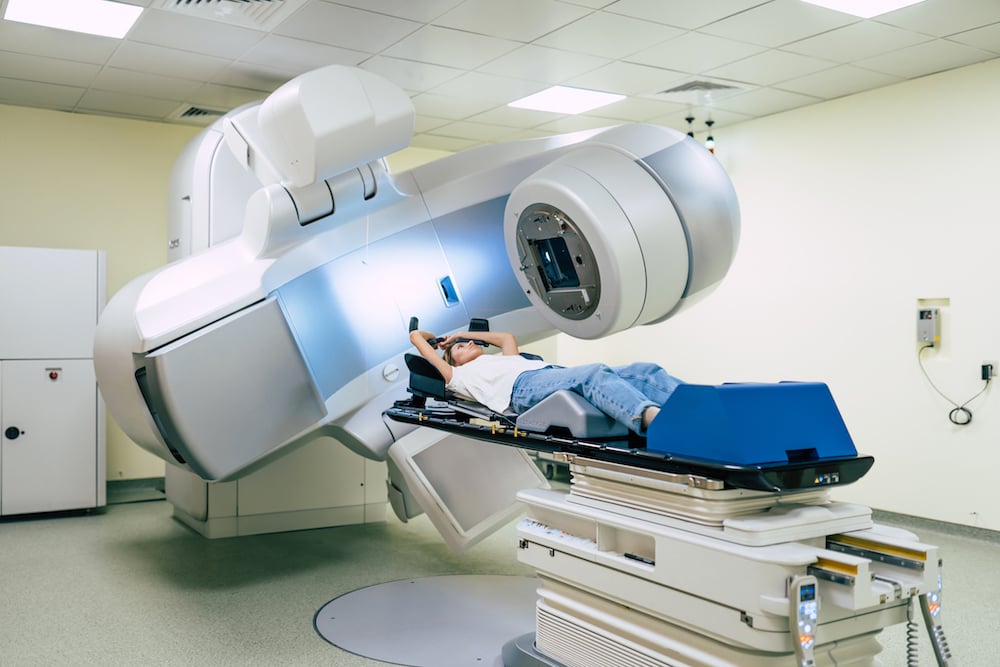What to Know About Radiation Therapy for Breast Cancer
5 min read

If you’ve been diagnosed with breast cancer, your cancer specialist may have recommended radiation therapy as a part of your individualized treatment plan. Radiation therapy is a type of cancer treatment that uses high-energy rays (or particles) to kill cancer cells. Let’s take a look at the types of radiation therapy, how it’s used for breast cancer, and the side effects you can expect.
How Radiation Therapy is Used in a Breast Cancer Treatment Plan
Depending on various factors, including the specific type of breast cancer and the stage, radiation therapy can be used in different ways:
- After breast-conserving surgery (lumpectomy), to ensure all of the cancer cells in the area have been destroyed.
- Before breast cancer surgery to reduce the size of the tumor. This may be given in combination with chemotherapy. Studies show this can help reduce the risk of the cancer coming back in the same breast or nearby lymph nodes.
- In some cases, after breast removal surgery (mastectomy). While it’s not always necessary to have radiation after mastectomy, if the tumor was larger than 5 cm, cancer cells were found in many lymph nodes, or if the surgery margins were positive for cancer cells, radiation may be used.
- If the breast cancer cannot be removed with surgery, radiation therapy can still be used to destroy the cancer cells.
- To help ease side effects if the cancer spreads to other parts of your body, such as the bones, spinal cord, or brain.
The recommended order for radiation and other treatments is specific to each patient’s situation and will be reviewed by the cancer care team collectively to determine the best next steps.
Types of Radiation Therapy for Breast Cancer
There are two main types of radiation therapy used to treat breast cancer: external radiation therapy and internal radiation therapy (brachytherapy).
External Beam Radiation Therapy (EBRT)
External beam radiation therapy is the most common form of radiation used to treat breast cancer. This method involves using a large machine called a linear accelerator to deliver beams of radiation to the area of your breast that has been affected by cancer. From outside the body, the rays are aimed directly at the targeted site while the machine moves around you, directing the beams from different angles.
- If you have had breast-conserving surgery, you will likely receive radiation to the entire breast.
- If cancer was found in your lymph nodes, radiation may be given to the lymph nodes under your arms, above your collarbone, and/or beneath your breastbone.
- If you have had a mastectomy, the radiation will be focused on your chest wall, your mastectomy scar, and anywhere you received drains following your surgery.
If radiation therapy is recommended after surgery, it will start a few weeks to a few months after you’ve had a chance to heal. If you are receiving chemotherapy as well as radiation therapy, treatment will usually begin after chemotherapy has finished.
Planning External Beam Radiation Therapy
Before starting radiation therapy treatments, images are taken of the breast to see exactly where it’s located and the shape of each tumor. With this information the radiation oncology team can determine the dose for each session and exactly where to direct the beams. You will also receive skin markings known as radiation tattoos. These marks are small, but necessary as they help the radiation therapist aim the radiation precisely where it's needed.
You can expect to receive radiation therapy five days a week for several weeks. If hypofractionated radiation therapy is an option, the total treatment time can be 4-6 weeks. Standard radiation therapy will usually take 6-8 weeks. The actual treatment will last no more than a few minutes, and the procedure will be painless.
Internal Radiation Therapy for Breast Cancer
Internal radiation therapy (more commonly called brachytherapy or high dose rate (HDR) brachytherapy) is another way to deliver radiation therapy. Rather than aiming radiation from outside the body, brachytherapy involves putting a source of radiation into your body.
To treat breast cancer in this way, one or more thin applicator tubes are placed directly into the affected area of the breast. Radioactive seeds or pellets are placed in the applicator tubes, left for a short period of time (about 10 to 20 minutes), and then removed. This process is repeated several times throughout your treatment period.
The goal of this form of radiation is to reduce the risk of breast cancer recurrence. It also limits the dose of radiation to surrounding normal tissue.
While internal radiation therapy is an effective way to deliver treatment to an exact area, it may not be appropriate for all breast cancer patients. Factors including tumor location and size may limit whether you are able to receive this treatment.
The American Brachytherapy Society recommends internal radiation therapy to women over the age of 45 following a lumpectomy if:
- The removed tumor is three centimeters or smaller in size
- The cancer has not spread to the lymph nodes
- No cancer cells were found in the rim of healthy tissue removed with the cancer
Internal radiation therapy is usually given over a period of five days. The length of the treatment will depend on your type of cancer, your other cancer treatments, and overall health. After the entire course of treatments is done, the catheter and device will be removed.
External Radiation Therapy Side Effects for Breast Cancer Patients
Treatment itself is painless. However, many patients experience skin changes over time in the area where treatment is given. It can be mild, similar to a sunburn with itching and redness, or it can become more severe including burning, soreness, peeling blisters and darkening of the skin on the breast.
The appearance of spider veins, called telangiectasis, may develop months or years after treatment. Usually painless, there can be a patch of tiny blood vessels that appear on the skin of the breast that received radiation therapy. For some it may cause some itching or mild pain.
Other common side effects of external radiation therapy are:
- swelling in the breast
- mild to moderate fatigue
- changes in skin sensation
- armpit discomfort
Breast Cancer Radiation Therapy at Rocky Mountain Breast Specialists
At RMBS, radiation therapy is often a part of the treatment plan because it’s highly effective when it comes to destroying cancer cells, even those that can’t be seen on an image.
If you’ve been diagnosed with breast cancer and would like to discuss a breast cancer treatment plan, request an appointment at one of our convenient Colorado locations.


